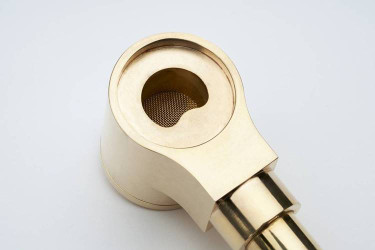Tobacco pipes come in a wide range of styles, sizes and materials. From beautiful briar pipes to compelling, hand-carved meerschaum pipes and more. As a result, it's safe to say that no matter your particular tastes there's a tobacco pipe out there that will satisfy them. Put a briar and a meerschaum pipe side by side, however, and it might seem they have very little in common, except that they're both used for smoking tobacco. But nothing could be further from the truth. In fact, all tobacco pipes share the same structural components and if you enjoy pipe tobacco it behooves you to know what they are. Read on to find out.
The Different Components of Tobacco Pipes
The following are the typical components that make up any given tobacco pipe.
The mouthpiece
The mouthpiece extends from the stem toward the user and is the part that is placed in the mouth to draw through. It attaches to the end of the stem where it forms an airtight seal so as not to allow smoke to leak out at the connecting point. The vast majority of mouthpieces are made from vulcanized rubber (vulcanite), ebonite or lucite and have either a tapered or saddled end. Every mouthpiece has either a round or flat opening through which air is drawn.
The lip
The lip is at the very end of the mouthpiece. It is typically a raised area that the user clenches between their lips or teeth in order to hold the pipe in the mouth. The raised lip also provides the user with some idea of how much of the mouthpiece is currently in their mouth. Without it the mouthpiece might slip out causing the pipe to fall or the user might lose track of where the end of the mouthpiece is and take too much of it into their mouth.
The peg
The peg is the part of the mouthpiece that fits into the stem creating the join between the two components. Pegs are notoriously fragile and are often the first thing to break on an older pipe. Most of the time you won’t see the peg as it’s inside the stem.
The stem
The stem is that part of the pipe that extends from the bottom of the bowl toward the mouthpiece. The stem and bowl are talked about separately but they are actually a single piece of briar wood, meerschaum or another material.
The bowl
The bowl is the round-ish part of the pipe where you pack the tobacco. Bowls vary in size and bowl exteriors can vary greatly in appearance depending on the style of the pipe.
The draught hole
The draught hole is the tunnel as it were that the smoke passes through on its way from the bowl to the mouthpiece.
The carbon layer
Not a structural part of the pipe, the carbon layer is gradually built up around the inside of the bowl through the process of repeatedly burning of tobacco. The carbon layer may not be anything to write home about as far as looks goes but it serves 3 important purposes:
For Quality Tobacco Pipes and Tobacco Pipe Accessories Trust Paykoc Pipes
Whether you are an absolute beginner, an experienced pipe aficionado or a smoke shop owner in search of wholesale tobacco pipes Paykoc Pipes is your one-stop shop. We offer an extensive line of pipes and smoking accessories both through our brick-and-mortar location and our online shop. So check us out today.

 US Dollars
US Dollars
